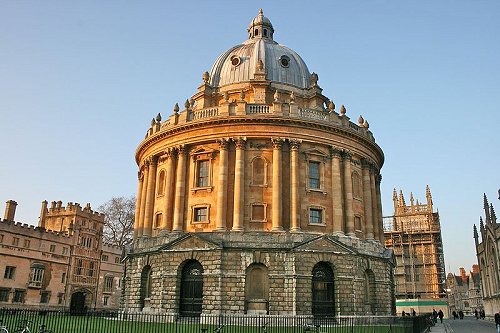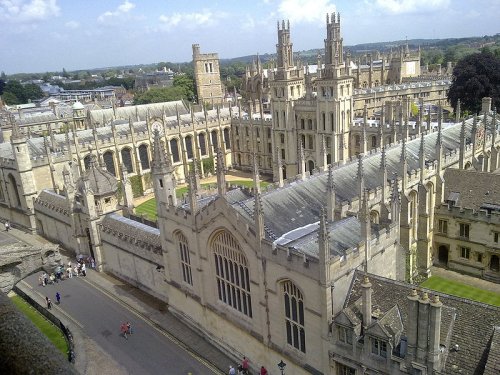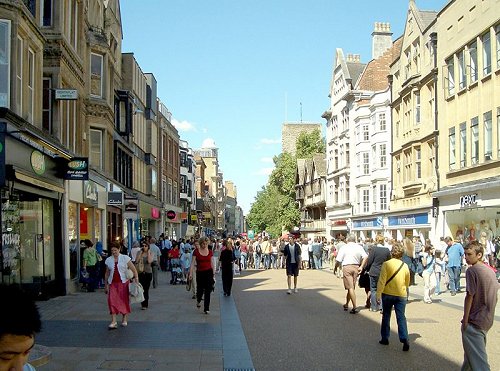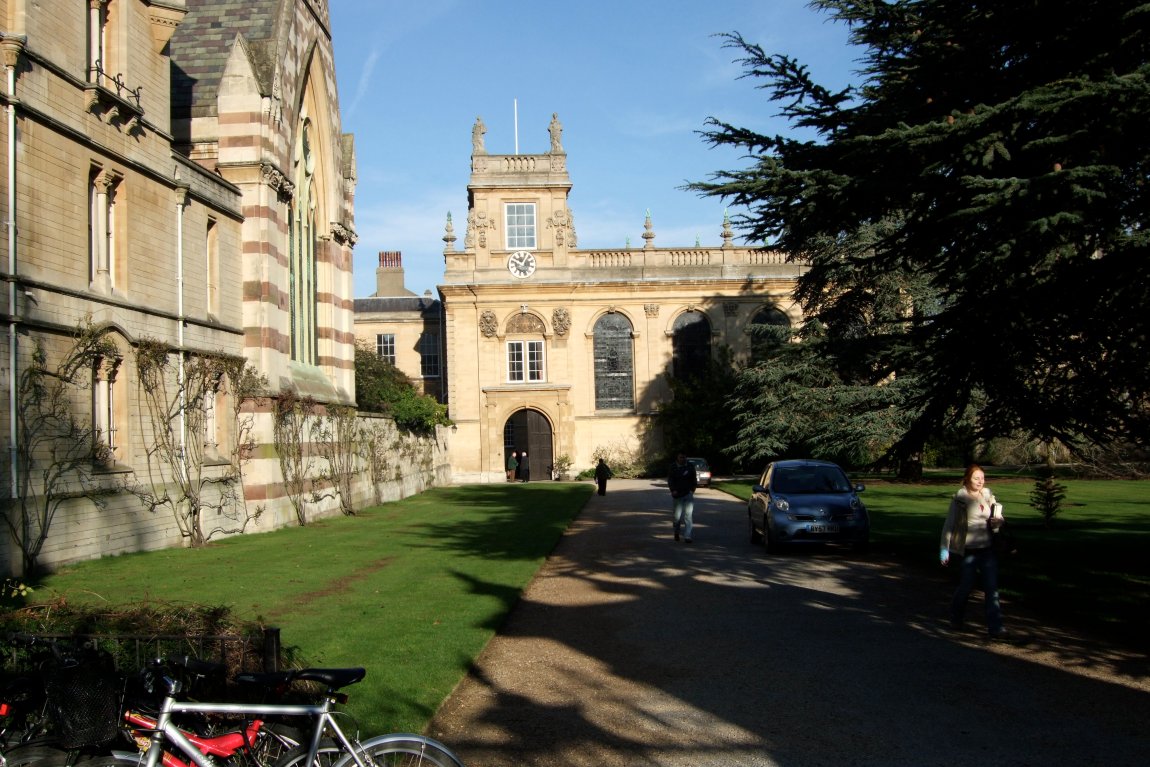Oxford is a famous university city in Oxfordshire, England. It is the home of the world-famous University of Oxford, the oldest university in the English-speaking world. The city has a population of 165,000 people. The rivers Cherwell and Thames flow through the city to converge south of the city centre.
Established in the 8th century, Oxford was originally known as Oxenaforda, or "ford of the ox", and began with the founding of St Frideswide's nunnery during that time. The first mention of the city appeared in the Anglo-Saxon Chronicle from AD 912. The city was destroyed during the Norman Invasion of 1066, and after the invasion, Oxford Castle was built as a symbol of Norman power over the city.
The University of Oxford first appeared in the records of the 12th century. Initially the students resided in approved halls, the precursor of colleges. The oldest college in Oxford is the University College, dating from 1249.
Christ Church Cathedral, Oxford, the college chapel, began as the Priory Church of St Frideswide. It took on the functioin of the cathedral of the Diocese of Oxford since 1546.
 Radcliffe Camera, the most prominent landmark of Oxford
Radcliffe Camera, the most prominent landmark of OxfordSource: https://commons.wikimedia.org/wiki/File:Radcliffe_Camera,_Oxford.jpg
Author: Mike Peel

Today Oxford has a cosmopolitan character, thanks to an influx of South Asian immigrants, residing in places such as Headington and Cowley Road. As much as 27% of the population of Oxford today comprises ethnic minority groups, including 16% non-white minorities.
Oxford is known as the "city of dreaming spires", a term coined by Matthew Arnold because of the harmonious architecture of the university buildings. The River Thames runs through Oxford, where for a distance of some 10 miles it is known as the Isis. The Oxford suburb of Cowley is renowned for carmaking and now produces the BMW MINI.
 All Souls College, Oxford
All Souls College, OxfordSource: https://commons.wikimedia.org/wiki/File:All_souls_college_from_above_and_to_the_west.jpg
Author: Ozeye

How to go to Oxford
By Plane: If you are coming from outside Britain, the nearest airport would be London Heathrow Airport. (Oxford does have a small airport but it is used mostly for private and charter flights.) From Heathrow Airport, you can take a bus operated by the Oxford Bus Company that takes you to the Oxford Gloucester Green Bus Station. The fare is £18 one way or £20 return.If you arrive at London Gatwick Airport, there's also a bus service from there for £22 one way and £29 return.
 Cornmarket Street, Oxford
Cornmarket Street, OxfordSource: https://commons.wikimedia.org/wiki/File:Cornmarket_St,_Oxford.jpg
Author: Grue

By Train: There are trains from London Paddington Railway Station to Oxford one in every half an hour. The journey takes a hour. Tickets cost £20 off peak without a railcard and £40 during peak times without a railcard. Tickets are also available online at a very low price - as low as £4 if you book way in advance of your travel.
By Road: Oxford is approximate 90km (55 mi) to the north west of London and 110km (70 mi) south east of Birmingham. The M40 motorway between London and Birmingham passes within seven miles of Oxford. The A34 road forms the western part of Oxford's bypass. Other trunk roads serving Oxford are the A40 road and the A420 road.
 Trinity College, Oxford
Trinity College, OxfordSource: https://commons.wikimedia.org/wiki/File:Trinity_College_Oxford.jpg
Author: Richard Peat

Exploring Oxford
Oxford is compact and walkable. Most of the sights are in the city centre and can be reached on foot. Most of the tourist attractions are well signposted. The only nuisance are the inconsiderate cyclists who often ride the bikes on the pavements posing a hazard to pedestrians.Places of Interest in Oxford
- Ashmolean Museum: Museum showcasing some of the finest art and antiques in Britain.
- Botanic Gardens of Oxford: Oldest botanic gardens in Britain.
- Bridge of Sighs: Bridge at Hertford College resembling the Bridge of Signs in Venice.
- Carfax Tower: The only remaining part of the 14th century Church of St Martin.
- Christ Church Cathedral: Cathedral of the diocese of Oxford.
- Holywell Music Room: The first building in Europe to be designed specifically for public musical performances.
- Martyrs' Memorial: Memorial to three Protestants burned at the stake for heresy.
- Museum of Oxford: Museum occupying a Victorian town hall showcasing the long history of Oxford.
- Museum of the History of Science: Museum in a magnificent 17th building displaying the collection of Elias Ashmole.
- Oxford Castle: The thousand-year-old castle now open to the public.
- Radcliffe Camera: Classical rotunda today housing the reading room of the Bodleian Library.
- Sheldonian Theatre: Traditional site of the graduation ceremonies of Oxford University.
- St Mary the Virgin Church: The official church of the University of Oxford.
- University Museum: Museum with a myriad collection ranging from a stuffed dodo to masks and totems from far-flung corners of the world.
Sights at Oxford University
- University of Oxford: The oldest university in Britain.
- Bodleian Library: One of the finest research libraries in the world, founded in 1320.
- Tom Quad: The largest college quadrangle in Oxford.
- All Souls College: College founded in 1438 by King Henry VI.
- Christ Church College: The largest of the colleges of Oxford.
- Corpus Christi College: College with a beautiful façade on Merton Street, founded in 1517.
- Lincoln College: One of the best-preserved medieval colleges of Oxford.
- Magdalen College: One of the most beautiful Oxford college.
- Merton College: The oldest college in Oxford, founded in 1264.
- New College: New only by name, this is one of the grandest colleges of Oxford founded by William of Wykeham in 1379.
- Queen's College: College with some of the finest 18th century buildings in Oxford.
- St John's College: College on St Giles founded by Cistercian scholars.
- Trinity College: College incorporating the earlier Durham College founded in 1286.
Oxford is  on the Map of cities in England
on the Map of cities in England
 Latest updates on Penang Travel Tips
Latest updates on Penang Travel Tips
Map of Ceremonial Counties of England

Copyright © 2003-2025 Timothy Tye. All Rights Reserved.

 Go Back
Go Back